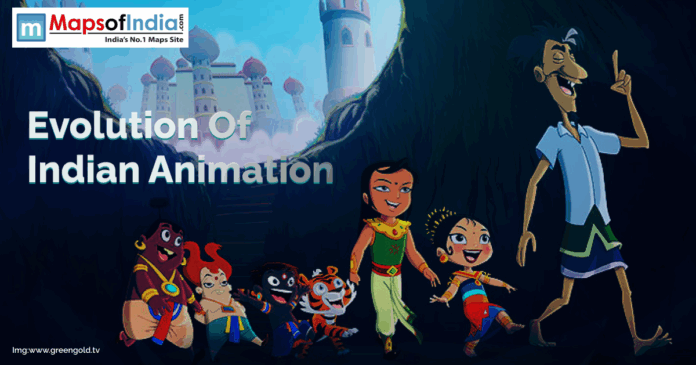The Indian animation industry is transforming rapidly. This industry has developed from humble hand-drawn shorts to cutting-edge digital films. This is a vibrant industry. In recent years, this industry has been valued at Rs. 16,000 crore. According to the Lumikai report, the projected annual growth of this industry is 20%. Early pioneers laid the foundation with their excellent creative abilities. Modern studios like Toonz and Green Gold drive global success. Iconic works like Hanuman and Kochadaiiyaan mark the milestones of this industry. Technology and storytelling fuel its rise.
Early Beginnings with Pioneering Efforts
The animation industry in India began in the silent era. The pioneer of Indian cinema, Dadasaheb Phalke, established The Pea Brothers in 1915. This stop-motion short used matchsticks as characters. This is known as India’s first animated film. Gunamoy Banerjee produced cartoons for New Theatres in the 1920s. He made films around many different subjects, like his 1934 short Peacemaker tackled political themes. This movie used the hand-drawn cel technique. With the establishment of Cartoon Films Limited in Mumbai in the 1950s Indian animation industry saw growth. Ram Mohan joined the industry in 1956 and was later called the father of Indian animation. He made the film Havoc in Heaven in 1961, an Indo-Chinese project, which gained acclaim. The establishment of the Films Division in 1948 produced shorts like The Banyan Deer in 1957. These animated movies reached rural audiences. Early animation was labour-intensive work. It blended Indian stories with global methods. These efforts built a creative foundation.
Growth Through Educational Animation in the 1970s
As the decade of the 1970s arrived, it brought structure and purpose to this industry in India. The animated feature of Bhimsain Khurana’s Ek Anek Aur Ekta in 1974 won a National Award. This Film Division short promoted unity via Doordarshan. The animation was mostly done using hand-painted acetate sheets. Ram Mohan’s RM-USL studio, founded in 1978, created ads for brands like Maggi. As Television grew with Doordarshan reached every household in India. Cartoons from around the world were imported, like Mickey Mouse, but at the same time, local content emerged. Ghayab Aaya, in 1986, was India’s first animated TV series. The same decade saw early computer animation experiments. According to the Nasscom report by 1979, more than 300 employees were working in this industry. Animated educational shorts were produced to shape young minds. This era bridged art and technology. It set the stage for commercial growth.
Commercial Boom and Studios in the 1990s
The 1990s marked a commercial leap. UTV Toons launched in 1996 with shows like Tenali Rama. It aired on Doordarshan. Animation studios like Crest Communications in Mumbai worked on Hollywood projects. The animation industry hit $500 million by 2000. Animation studios like Toonz Animation, which was founded in 1999 in Trivandrum, partnered with many global companies. The 2005 film Hanuman was a big hit for an animated feature. Software like Toon Boom made 2D production easy. Studios like Famous House of Animation made animated ads for global companies like Coca-Cola. The decade of the 2000s saw studios professionalize. Indian studios blended local talent and achieved global demand. Indian animation gained international recognition.
Digital Revolution and 3D Animation in the 2000s
The 2000s saw digital innovation. Computers were able to do 3D animation with tools like Maya. In 2005, Hanuman became India’s first 3D feature. Directed by V.G. Samant earned Rs. 8.5 crore. Many experiments also happened in the Indian animation industry, like Yash Raj Films’ Roadside Romeo in 2008 used 3D for Bollywood stars. The Indian studio Rhythm & Hues in Mumbai worked on the Oscar-winning feature Life of Pi in 2013. With steady progress, this industry grew to Rs. 2,000 crore by 2010. The children’s cartoon by Green Gold’s Chhota Bheem was launched in 2008 and has reached 40 million viewers on Pogo. The shift of animation to 3D was transformative. It brought Indian stories to global screens.
Bollywood and Animation Integration in the 2010s
The 2010s saw animation merge with the mainstream movie industry. The animated feature Kochadaiiyaan, which was released in 2014, used motion capture with Rajinikanth. This movie reportedly earned Rs. 42 crore. 3D animated features like Chaar Sahibzaade were released in 2014, depicting Sikh history. That movie grossed Rs. 70 crore. The Indian animation industry reached Rs. 5000 crore by 2015. According to the Nasscom report, this industry created 15000 jobs. Many milestone animation works were also seen in these early stages, like Red Chillies VFX worked on Ra. In 2011, which gave they National Awards. Streaming platforms like Netflix also entered the Indian animation market with movies like Mighty Little Bheem in 2019. It has a viewership of 27 million, reaching households globally. Bollywood’s star power boosted animation. It expanded audiences and creative scope.
Global Reach and Original IP in the 2020s
As the decade of the 2020s arises, the Indian animation industry starts focusing more on Indian intellectual property. The recently released animation feature by Hombale Films, Mahavatar Narsimha, uses advanced CGI and has broken earning records worldwide. Animation series like Paruvam – The Season explores adventure with vibrant animation. The animated feature of the beloved Indian animated character Chhota Bheem films grossed Rs. 50 crore. The animation industry in India has reached Rs. 16000 crore in 2025. Studios like Toonz are in collaboration with global giants like Disney. The Pandavas in 2022 retold mythology. Indian animation earns global acclaim. It blends heritage with cutting-edge tech.
Challenges and Future Horizons
Indian animation has faced many challenges over the period of time. Acquiring funding for original content is the most difficult part. According to the Lumikai report, 70% of revenue comes from outsourcing. Due to limited training, talent shortages happen. Indian animation studios have a 20% skill gap compared to global animation studios. Piracy cuts earnings by 30%. Rural studios do not have proper infrastructure. The AVGC policy aims for $10 billion by 2030. Partnerships with Netflix and Disney by local studios are giving new light to the Indian animation industry. A Lumikai report predicts 25% growth via these partnerships. Original IPs like Mahavatar Narsimha shine. The future is bright despite hurdles.
Conclusion
Indian animation’s journey is inspiring, which is filled with many ups and downs. From The Pea Brothers in 1915 to Mahavatar Narsimha in 2025, it has seen many changes and thrived on them. Pioneers like Ram Mohan set the stage for Indian animation’s future. Studios like Toonz and Green Gold are leading globally. Films like Hanuman and Kochadaiiyaan show the power of original Indian IPs. In recent years, this industry has reached the mark of Rs. 16000 crore and is growing fast. Challenges like funding are still there. Yet streaming and global ties fuel optimism. This industry has a blend of culture and innovation. Its story is just unfolding.





